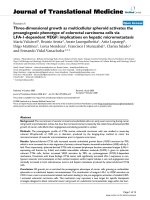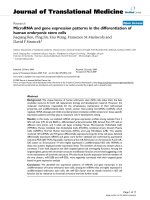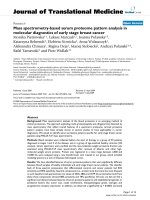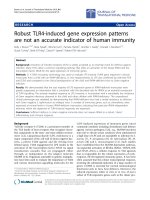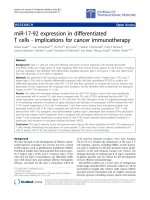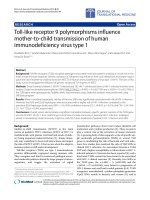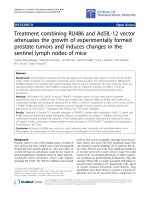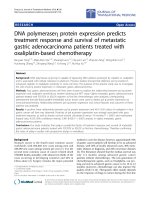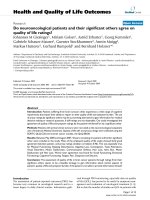Báo cáo hóa học: " Robust TLR4-induced gene expression patterns are not an accurate indicator of human immunity" ppt
Bạn đang xem bản rút gọn của tài liệu. Xem và tải ngay bản đầy đủ của tài liệu tại đây (1.36 MB, 12 trang )
RESEARC H Open Access
Robust TLR4-induced gene expression patterns
are not an accurate indicator of human immunity
Kelly L Brown
1,2,4*
, Reza Falsafi
1
, Winnie Kum
1
, Pamela Hamill
1
, Jennifer L Gardy
1
, Donald J Davidson
2,3
,
Stuart Turvey
2
, Brett B Finlay
1
, David P Speert
2
, Robert EW Hancock
1
Abstract
Background: Activation of Toll-like receptors (TLRs) is widely accepted as an essential event for defence against
infection. Many TLRs utilize a common signalling pathway that relies on activation of the kinase IRAK4 and the
transcription factor NFB for the rapid expression of immunity genes.
Methods: 21 K DNA microarray technology was used to evaluate LPS-induced (TLR4) gene response s in blood
monocytes from a child with an IRAK4-deficiency. In vitro responsiveness to LPS was confirmed by real-time PCR
and ELISA and compared to the clinical predisposition of the child and IRAK4-deficient mice to Gram negative
infection.
Results: We demonstrated that the vast majority of LPS-responsive genes in IRAK4-deficient monocytes were
greatly suppressed, an observation that is consistent with the described role for IRAK4 as an essential component
of TLR4 signalling. The severely impaired response to LPS, however, is inconsistent with a remarkably low incidence
of Gram negative infections observed in this child and other children with IRAK4-deficiency. This unpredicted
clinical phenotype was validated by demonstrating that IRAK4-deficient mice had a similar resistance to infection
with Gram negative S. typhimurium as wildtype mice. A number of immunity genes, such as chemokines, were
expressed at nor mal levels in human IRAK4-deficient monocytes, indicating that particular IRAK4-independent
elements within the repertoire of TLR4-induced responses are expressed.
Conclusions: Sufficient defence to Gram negative immunity does not require IRAK4 or a robust, ‘classic’
inflammatory and immune response.
Background
Toll-like receptor-4 (TLR4) is a prominent member of
the TLR family of host receptors that recognize micro-
bial components in the intra- and extra-cellular environ-
ment [1,2]. Lipopolysaccharide (LPS, endotoxin) is a
major component of the cell wall of Gram negative bac-
teria, a potent TLR4 agonist and the driving force
behind sepsis. TLR4 engagement by LPS results in the
activation of the transcription factor NF Bviasignal
transduction cascades that are propagated either
through, or independent of, the adaptor molecule
MyD88 [2-4]. Organisms amenable to genetic manipula-
tion have been used to evaluate the importance of TLR4
and various downstream signalling molecules for the
(LPS-)induced expression of immunity genes (most
commonly cytokines including chemokines) and defence
against various pathogens [5,6], e.g., MyD88-knockout
mice fail to elevate serum cytokines when administered
a high dose of LPS and are susceptible to i nfection by S.
aureus [7], P. aeruginosa [8], M. tuberculosis [9], M.
avium [10] and L. monocytogenes [11]. Such studies
have established that the MyD88-dependent pathway,
via sequential activation of IRAK4, IRAK1, TRAF6, IKK
and NFB, drives a cellular response to TLR agonists
that is responsible for the robust expression of early-
response, NFB-regulated immunity genes. It has been
often assumed that t his robust transcriptional response,
involving the substantial induction of a large number of
genes (>1000) is essential for normal immunological
function(s) and, in turn, host defences. Moreover, the
reduced expression, eit her in vitro or in vivo,ofjusta
subset of TLR-responsive genes, such as the classic pro-
* Correspondence:
1
Centre for Microbial Diseases and Immunity Research, Department of
Microbiology and Immunology, University of British Columbia, Vancouver,
British Columbia, V6T 1Z3, Canada
Brown et al. Journal of Translational Medicine 2010, 8:6
/>© 2010 Brown et al; licensee BioMed Central Ltd. This is an Open Access article distributed under the terms of the Creative C ommons
Attribution License ( which permits unrestricted use, distribution, and reproduction in
any medium, provided the original work is properly cited.
inflammatory cytokines (TNF-a,IL-6),chemokines(IL-
8, Gro-a/CXCL1) and antibacterials (antimicrobial pep-
tides, reactive oxygen/nitrogen species) is often accepted
as sufficient evidence to predict a defect in host defence
against infectious agents.
Since 2003, eighteen individuals, primarily children,
have been identified with a mutation in the gene that
encodes IL-1R-associated kinase 4 (IRAK4) that lies
immediately downstream of MyD88 in the TLR signal-
ling cascade (re viewed in [12]). We previously reported
an IRAK4-deficiency in a 4-year old child due to a
homozygous single base substitution (C887T) in exon 8
of the IRAK4 gene that introduced a premature stop
codon (Q293 X) [13,14]; an identical mutatio n occurs in
the majority of cases of IRAK4 immunodeficiency.
PBMC from children with IRAK4-deficiency consistently
show impaired in vitro responsiveness, as measured by
the production of pro-infl ammatory cytokines, to
selected TLR agonists [12-14]. Given the pivotal position
of IRAK4 in the TLR pathway and the failed responsive-
ness of IRAK4-deficient (human and mouse) cells to
both Gram pos itive (LTA, PGN) and Gram negative
(LPS) TLR agonists, it seemed logical that a defect in
IRAK4 would render patients susceptible to a broad
range of both Gram positive and Gram negative bacter-
ial pathogens. In contrast, children with an IRAK4-defi-
ciency have a remarkably mild immunodeficiency with
enhanced susceptibility to infection by only a narrow
range of Gram positive bacteria, particularly S. aureus
and S. pneumoniae [12-18]. IRAK4 knockout mice are
also more susceptible to infections by (Gram positive) S.
aureus than wild-type mice [19]. We were intrigued by
the relatively small number of documented cases of
Gram negative infections in IRAK4-deficient children
[20,21] in light of a consistently poor cellular responses
to LPS. It should be noted that these children a re pre-
scribed a regimen of antibiotics that are effective only
against Gram positive bacteria, thus prophylaxis can not
explain their apparent immunity to Gram negative infec-
tions. IRAK4 knockout mice and IRAK4-kinase-dead
knock-in mic e also fail, in vitro and in vivo,toproduce
inflammatory cytokines in response to LPS and are pro-
tected against LPS-induced sepsis in vivo [1 9,22-24].
There is, however, a resounding lac k of experimental
evidence that IRAK4-deficiency (in humans or mice)
actually compromises host def ences to Gram negative
infection.
Herein we provide the first evidence that IRAK4
knockout mice are not overwhelmed by challenge with
the Gram negative bacterium S. typhimurium.These
results substantiated our hypothesis that the under-
whelming number of documented Gram negative bac-
terial infections in IRAK-deficient children is likely
attributable to sufficient host defence. The widely
accepted notion that the absence of IRAK4 should com-
promise immunity to Gram negative pathogens was
based primarily upon results demonstrating the compro-
mised expression of a small number of classic LPS-
responsive, pro-inflammatory markers (primarily cyto-
kines) as well as the assumption that high expression of
these genes in particular was required for immunity.
Here we evaluated the i mpact of IRAK4- deficiency on a
global scale using 21 K microarray technology to analyze
total gene expression in LPS-activated monocytes from
an IRAK4-deficient patient. In accordance with previous
reports, and counter-intuitive to a resistance to Gram
negative infection, there was a profound failure of
IRAK4-deficient monocytes to produce, in response to
LPS, substantial levels of classical immunity genes (cyto-
kines, chemokines, NFB subunits). Upon cl oser exami-
nation, however, it was discovered that the expression of
these genes, while low, was seldom abolished. Moreover,
approximately 20% of LPS-responsive genes, including
cer tain chemokin es, transcription factors and regula tors
of translation, were expressed at similar level s in control
and IRAK4-deficient cells. We conclude that IRAK4 is
indeed essential for LPS-induced signal transduction via
the MyD88-dependent pathway that is responsible for
rapid and vigorous transcription of classical NFB-regu-
lated immunity genes, but that neither IRAK4 nor a
robust transcriptional response (typical of cells exposed
to LPS) are required for immunity to Gram negative
infections.
Methods
PBMC isolation and stimulation
PBMC from healthy volunteers and the patient were
prepared as previously describ ed [25], in accordance
with UBC Clinical Research Ethics Board protocol C04-
0193. Due to the rarity of this syndrome only a single
patient was available to us; however previous studies
have demonstrated similar phenotypic responses for
most IRAK4 deficient patients including this one
[13-18]. PBMC (2-3 × 10
7
cells at 5 × 10
6
cells/ml) were
stimulated for 4 hr at 37°C 5% CO
2
with 100 ng/ml
Escherichia coli 0111:B4 LPS (Invivogen). Based on pre-
vious studies, LPS-induced gene transcription in mono-
cytes peaked (with respect to the number of genes and
the magnitude of gene expression) after 4 hr of stimula-
tion, at which point a substantial level of inflammatory
cytokines could also be detected in the tissue culture
supernatant [25]. We previously reported comparable
cytokine responses i n PBMC isolated from adults and
children following in vitro stimulation with TLR ago-
nists [26] ; thus for ethi cal reaso ns we used adult PBMC
as controls in these experiments. All reagents were
tested for the ab sence of endotoxin and reconstituted in
endotoxin-free water.
Brown et al. Journal of Translational Medicine 2010, 8:6
/>Page 2 of 12
Detection of cytokines and chemokines
Following culture of PBMC, the tissue culture superna-
tants were centrifuged and stored at -80°C and/or mea-
sured for cytokines using a cytokine 5-Plex kit (Biosource
International Inc) and Luminex 100™ StarStation software
(Applied Cytom etry Syst ems) as de scribed [ 25]. CCL22
(MDC) secretion in tissue culture supernatants was
detected with a capture ELISA (R&D Systems).
Positive selection of CD14
+
monocytes and DNA
microarrays
Following culture of PBMC, monocytes were positively
selected using anti-CD14 conjugated magnetic beads
(M450; Dynal; Invitrogen) as described [27,28]. RNA
was isolated from monocytes with RNeasy Mini kit and
analyzed using an Agilent 2100 Bioanalyzer (Agilent
Technologies) as described [25]. Equal quantities of
RNA from each of five healthy individuals were pooled
per experimental condition to gener ate a reference sam-
ple of the average (n = 5) expression of genes in control
monocytes. The profile of LPS-responsive gene expres-
sion in the control pool was consistent with what has
been observed by us in monocytes from individual sub-
jects [29]. Microarray analyses were per formed on
21,000 gene arrays as previously described [29], analyzed
by ArrayPipe software, version 1.6 [30], and the data
deposited into ArrayExpress under accession number E-
FPMI-7. Differentially expressed genes were overlayed
on known signal transduction pathways using Cytos-
cape, an open-source bioinformatics visualization soft-
ware [31]. The Gene Ontology Tree Machine software
[32] was used to identify gene ontology (GO) categories
and biological processes with a significantly enriched
(ratio >1.0 and p < 0.01) number of differentially
expressed genes (indicative of dysregulation) in the
patient’s monocytes.
Quantitative real-time PCR (qPCR)
Differential gene expression was validated using the
SuperScript™ III Platinum® Two-Step qRT-PCR Kit with
SYBR® Green (Invitrogen) [25], using 10 ng of total
RNA as the starting material. Reported fold changes in
gene expression were normalized to GAPDH in each
sample and were relative to the expression of the gene
in resting control monocytes. The result of qPCR ana-
lyses of more than twe nty, TLR-inducible, NFB-regu-
lated genes was in agreement with the microarray gene
expression data 84% of the time; a correlation indicative
ofareliablemicroarraydatasetwitharelativelylow
incidence of false results.
Bacterial culture and infection of mice
IRAK4
-/-
mice on the C57BL/6 background [19] were
obtained from the Canadian Network for Vaccines and
Immunotherapeutics of Cancer and Chronic Viral Dis-
eases (CanV ac). Sex- and age-m atched control C57BL/6
mice were purchased from Jackson Labor atories (Bar
Harbor, Maine). Animals were used at 8-10 weeks of
age. Studies were performed under pathogen-free condi-
tions according to the standard animal care guidelines
and pro tocols of the UBC Animal Care Commit tee and
Canadian Council on Use of Laboratory Animals. Sal-
monella serovar Typhimurium wild-type strain SL1344
[33] was grown with overnight shaking (220 rpm) in 3
ml Luria-Bertani (LB) broth with 50 μg/ml strepto mycin
at 37°C for 18 hr. Groups of eight mice were infected by
oral gavage with approximately 1 × 10
7
CFU in 100 μl
of sterile PBS. Infected mice were monitored twice daily.
Mice that showed extreme distress or became moribund
were euthanized and survival of the animals was
recorded.
Results
IRAK4-deficient mice survive infection by the Gram
negative pathogen Salmonella typhimurium
To validate the unusually low occurrence of Gram-nega-
tive infe ctions in IRAK4-deficient children, IRAK4-defi-
cient mice were challenged with the Gram negative
bacterium, S. typhimurium.ResultsshowninFigure1
demonstrated no significant difference in survival rates
between IRAK4-deficient mice and wild type mice fol-
lowing challenge with S. typhimurium. Thus, the
absence of IRAK4 does not render anima ls defenceless
against a Gram negative bacterial challenge. These data
together with that of Suzuki et al demonstrated that
IRAK4 knockout mice are highly susceptible to Gram
positive [19] but not necessarily Gram negative bacterial
infections (Figure 1), an infection profile that emulates
that of children with an IRAK4 deficiency. Thus these
data strengthen our hypothesis that immunity, as
opposed to prophylaxis or a lac k of expo sure to Gra m
negative bacteria, is responsible for the underwhelming
number of documented Gram negative infections in
children with IRAK4-deficiency.
Gene expression was generally severely compromised in
IRAK4-deficient monocytes stimulated with LPS
The long-standing assumption that any deficiency in the
major TLR to NFB pathway (such as an IRAK4-defi-
ciency) would c ompromise immunity to Gram negative
bacteria [34-36] was based on a substantial amount of
published data demonstrating compromised expression
in vitro of a limited set of LPS-induced, ea rly-response,
NFB-regulated, pro-inflammatory markers in cells defi-
cient for various components of the TLR to NFB path-
way (including IRAK4). A functional gen omics approach
was utilized here to view the broader impact of an
IRAK4 deficiency on LPS-induced gene expression.
Brown et al. Journal of Translational Medicine 2010, 8:6
/>Page 3 of 12
Blood monocytes were obtained from an IRAK4-defi-
cient child and subsequently stimulated in vitro in two
independent experiments, two months apart. With
human 21 K oligo-based DNA microarray technology,
the expression of genes in IRAK4-deficient monocytes
from each sampling was evaluated, in triplicate, relative
to gene expression in monocytes from five healthy indi-
viduals. Previous studies that employed a similar metho-
dology [28,29] served as a reference to confirm normal
LPS-responsive g ene expression in the healthy, control
pool of monocytes.
The expression of more than 500 genes in IRAK4-defi-
cient cells stimulated with LPS was significantly different
compared to that in control cells (567 genes, differential
fold change ± 1.5, Student’s t-test p-value ≤ 0.05, results
deposited in ArrayExpress, accession number E-FPMI-7).
An overlay of the gene expression data on a protein map
of the TLR-to-NFB signal t ransduction pathway illu-
strated that the majority of differentially expressed genes
associated with this pathway were i) suppressed relative
to gene expression in control monocytes and ii) tended
to congregate downstream of the IB-NF Bcomplex
(Figure 2). Gene ontology (GO) analysis [32] of the differ-
ent ially expressed genes predicted that 56 GO categories
were perturbed in IRAK4-deficient patients; these consti-
tuted 5 major biological pr ocesses (p < 0. 01) nam ely
‘ immune response’ , ‘ response to biotic stimulus’,
‘response to stress’, ‘ cell adhesion’ and ‘nega tive regula-
tion of cellular processes’ (data not shown).
Thus, the microarray analysis of monocytes from an
IRAK4-deficient child revealed a substantial disturbance
in LPS-induced gene expression, in particular in genes
regulated by the TLR-to-NFB pathway and associated
with biological processes related to immunity and cellu-
lar responsiveness to stimuli. This global analysis of
gene expression in IRAK4-deficie nt monocytes was in
accordance with previ ously published results that ana-
lyzed small subsets of inflammatory genes/proteins and
confirmed the previously ascribed role of IRAK4 in
mediating signalling from TLR4 to genes downstream of
NFB.
Figure 1 IRAK4-deficient mice maintain defence against Gr am
negative bacteria. IRAK4
-/-
(dotted line) and age- and sex-
matched C57BL wild type (solid line) mice were infected with S.
typhimurium SL1344 and monitored for survival (y-axis) over time (x-
axis). The result is representative of two independent experiments
where lack of statistical significance (p = 0.69 and p = 0.13) for
differential survival between two groups of eight infected mice was
determined by the chi-square test.
Figure 2 Differentially expressed genes in LPS-stimulated IRAK4-d eficien t monocytes dow nstream of NFB.Usingtheopen-source
bioinformatics visualization software Cytoscape [31] gene expression in LPS-stimulated, IRAK4-deficient monocytes was overlayed on the TLR4
signal transduction pathway downstream of NFB. Gene names are given in the left panel and gene expression in the right panel. The relative
expression of the gene in IRAK4-deficient monocytes is depicted by the colour of the nodes on the protein map; green nodes indicate lower
expression and red nodes indicate higher expression in IRAK4-deficient monocytes relative to that in a control pool of monocytes.
Brown et al. Journal of Translational Medicine 2010, 8:6
/>Page 4 of 12
Expression of NFB-regulated, pro-inflammatory genes
was compromised to varying degrees in IRAK4-deficient
monocytes
Cytokines, chemokines and certain antimicrobial pep-
tides are TLR-sensitive, early response genes of the
innate immune system that are commonly used to pre-
dict host defence and infectious disease risk. A subset of
these TLR-to-NFB-regulated immunity genes revealed
in the microarray analyses were select ed for further
investigation. Genes were selected if they fit one or
more of t he following criteria (i) the gene was regulated
by cellular activation wit h LPS (ii) the gene was a classic
pro-inflamma tory mediator, for e.g., a cytokine (TNF-a,
IL-6), chemokine (IL-8, Gro-a/CXCL1) or antibacterial
(DEFB1) (i ii) in previously published work, alteration of
the e xpression of the gene or protein product, either in
vitro or in vivo, was predicted to influence host defence,
or (iv) the gene served as an internal control (for e.g.,
induction of NFB subunits) . Real-time quan titative
PCR(qPCR)andELISAwereusedtoconfirmthe
microarray results for relative gene expression between
control and IRAK4-deficient monocytes, and to establish
the absolute expression of mRNA and protein prior to
and following stimulation with LPS.
The expression of classic pro-inflammatory cytokines
and chemokines including TNF-a, IL-6, IL-12b, IL-8,
Gro-a/CXCL1, MCP-2/C CL8 and MIP-3a/CCL20 was
compro mised in LPS-stimulated IRAK4-deficient mono-
cytes compared to LPS-stim ulated control monocytes
(Figure 3 and Table 1). While the expression of these
genes was unanimously compromised, the degree of
suppression varied considerably, from 5- to 100- fold
reduction in expression (Figure 3A, Table 1). The rela-
tive level of protein expressed by PBMC was also heavily
compromised (ELISA shown for TNF- a,IL-8,IL-6in
Figure3B).Thesedatawereconsistentwithprevious
reports of low levels of cytokines detected in the TCS of
LPS-stimulated PBMC from this patient and other indi-
viduals with mutations in the IRAK4 gene [12-18] as
well as diminished, but not absent levels of TNF-a and
IL-6 in the serum of IRAK4-kinase dead (KD) knockin
mice following in vivo administration of LPS [37]. These
data (Figure 2, Figure 3, Table 1) illustrated that gene
transcription and protein secretion of key pro-inflamma-
tory mediators, while highly variable, was not completely
abolished in IRAK4-deficient monocytes exposed to LPS.
Identification of LPS-responsive, IRAK4-independent
immunity genes
While LPS-induced expression of the majority of NFB-
regulated genes w as lowered in IRAK4-deficient mono-
cytes, the TLR-to-NFBpathwaymap(showninFigure
2) revealed a subset of genes tha t were expressed at
similar (white nodes) or higher (red nodes) levels in
IRAK4-deficient and control cells. It was discovered that
approximately 20% of LPS-responsive genes were
expressed in IRAK4-deficient monocytes in a similar
manner to that observed in control cells. A subset of
LPS-responsive gene s associated with host defence that
were induced or suppressed to a similar extent (<1.2
fold difference) in control and IRAK4-deficient mono-
cytes are listed in Table S1, Additional file 1 (microarray
data). Genes of this nature encoded a diverse r ange of
proteins involved in immunity including, but not
restricted to, chemokines (MDC/CCL22), antibacterial
agents (DEFB1 ), transcription factors (FOS, JUN, RELB),
cytokine receptors (IL13RA1) and mRNA-destabilizing
agents (ZFP36L2). The uncompromised expression of
these genes in IRAK4-deficient cells was confirmed by
qPCR (Table 1).
The relatively normal expression of the chemoattrac-
tant MDC/CCL22 and the chemotactic host defence
(antimicrobial) peptide defensin-b-1 (DEFB1) in IRAK4-
deficient monocytes (Figure 4, Table 1) contrasted the
compromised expression of the chemokines IL-8 (neu-
trophil chemoattractant), Gro-a/CXCL1 (neutrophil che-
moattractant), MCP-2/CCL8 (monocyte, lymphocyte,
basophil, eosinophil chemoattractant) and MIP-3a/
CCL20 (lymphocyte chemoattractant) (Table 1). The
expression of MDC/CCL22 was fou nd to be rest ricted
to CD14
+
PBMC (monocytes) and expression in IRAK4-
deficient monocytes was equiva lent to or greater than
expression in control monocytes (Figure 4B). ELISA was
employed to demonstrate that LPS (24 hr) induced the
secretion of 3-fold more MDC (3.3 ± 0.6) by the
patient’s PBMC compared to PBMC from adult or age-
matched children (Figure 4C). Other CC family mem-
bers including MPIF/CCL23 and CCL28 (chemotactic
for monocytes, CD4
+
and CD8
+
T cells) and the chemo-
kine receptor CXCR3 were also expressed at normal
levels in IRAK4-deficient cells (ArrayExpress E-FPMI-7).
Given that monocytes, dendritic cells, NK cells, and acti-
vated T cells are all chemoattracted by MDC/CCL22,
the heightened expression of this chemokine alone has
the potential to recruit essential immune cells and thus
substantiallycompensateforthecollectiveabsenceof
chemokines Gro-a/CXCL1, MCP-2/CCL8, MIP-3a/
CCL20 and IL-8.
Gene expression in IRAK4-deficient monocytes was
subject to transcriptional and translational regulation
Induced genes in LPS-stimulated, IRAK4-deficient
monocytes were likely the result of signal transduction
via the MyD88/IRAK4-independent, TRIF/TRAM-
dependent arm of the TLR4 pathway. Clearly however,
LPS-induced activation o f the MyD88/IRAK4-indepen-
dent pathway did not completely compensate for a
defect in the MyD88-dependent pathway, neither in the
Brown et al. Journal of Translational Medicine 2010, 8:6
/>Page 5 of 12
number of expressed genes nor magnitude of their
expression.
Kinetic models have estimated that MyD88/IRAK4-
independent activation of NFBviaTRIF/TRAMlags
the MyD88-dependent pathway by approximately 30
min [38]. We and others previously demonstrated that
cells from the IRAK4-deficient patient [13,14] and
MyD88-deficient mice [39] do indeed activate NFB
shortly after exposure to LPS. The depletion of cytoplas-
mic pools of NFB as a consequence of nu clear
translocation stimulates new transcription of NFBsub-
units in order to replenish cytoplasmic supplies. T his
phenomenon was observed here (Figure 5A, Table 1) for
LPS-activated control monocytes that induced the com-
pensatory expression of all five NFBsubunits:NFB1/
p50, NFB2/p52, RelA/p65, RelB an d c-Rel.Thecom-
pensatory expression of all subunits except RelB was
however diminished in IRAK4-deficient cells. The
expression of NFB1/p50 and c-Rel was significantly (p
< 0.05) more impaired after LPS activation than two
Figure 3 Expression of inf lammatory cytokines and chemokines in IRAK4- deficient monocytes. A Expre ssion of IL-6, IL-8, IL-12b,TNF-a,
Gro-a/CXCL1 and MIP-3a/CCL20 in the healthy control pooled monocytes (white bars) and in both biological replicates of the patient’s
monocytes (black bars) were evaluated, in duplicate, by qPCR following a 4 hr incubation in the absence or presence of LPS (X-axis). B IL-6, IL-8
and TNF-a were also measured in the tissue culture supernatant of stimulated PBMC by multiplex cytokine bead immunoassays. The Y-axis
represents fold change (log scale) in gene expression relative to unstimulated control monocytes (qPCR) or pg/ml of protein determined by the
cytokine assay. Differences in expression or protein secretion were determined to be statistically significant by Student’s two tailed T-test with a
value of p < 0.15 (*), p < 0.1 (**), p < 0.05 (***) and p < 0.003 (****).
Brown et al. Journal of Translational Medicine 2010, 8:6
/>Page 6 of 12
Table 1 Gene expression by qPCR in resting or LPS-activated IRAK4-deficient monocytes relative to gene expression in
unstimulated control cells
Gene Name Monocytes Resting LPS
DEFB1
Control
a
1.1 ± 0.6
up
12.6 ± .0
=
IRAK4 Q293X 1.9 ± 0.9 9.6 ± 0.9
Fos
Control 1.5 ± 0.1
=
0.3 ± 0.0
=
IRAK4 Q293X 1.3 ± 0.0 0.3 ± 0.1
Gro-α (CXCL1)
Control 1.0 ± 0.2
dn
6.3 ± 1.2
dn
IRAK4 Q293X 0.3 ± 0.0 0.3 ± 0.0
IL-6
Control 1.1 ± 0.6
dn
185.4 ± 110.0
dn
IRAK4 Q293X 0.4 ± 0.5 1.8 ± 2.1
IL-8
Control 1.0 ± 0.0
=
24.1 ± 5.5
dn
IRAK4 Q293X 0.9 ± 0.8 2.0 ± 1.4
IL-12β
Control 1.0 ± 0.4
dn
181.7 ± 8.0
dn
IRAK4 Q293X 0.2 ± 0.1 1.9 ± 0.8
IL-13RA1
Control 1.0 ± 0.1
=
0.3 ± 0.0
up
IRAK4 Q293X 1.1 ± 0.3 1.9 ± 0.1
IFN-γ
Control 1.0 ± 0.1
dn
11.0 ± 0.3
dn
IRAK4 Q293X 0.4 ± 0.1 0.8 ± 0.3
IRF1
Control 1.0 ± 0.1
dn
6.7 ± 0.1
dn
IRAK4 Q293X 0.6 ± 0.1 3.1 ± 0.2
IκBζ
Control 1.1 ± 0.5
dn
1.3 ± 0.3
dn
IRAK4 Q293X 0.4 ± 0.2 0.5 ± 0.1
Jun
Control 1.0 ± 0.0
=
0.9 ± 0.2
up
IRAK4 Q293X 0.9 ± 0.3 1.7 ± 0.4
MCP-2 (CCL8)
Control 1.0 ± 0.0
dn
9.4 ± 0.0
dn
IRAK4 Q293X 0.1 ± 0.0 1.8 ± 0.2
MDC (CCL22)
Control 1.1 ± 0.5
dn
4.1 ± 1.2
up
IRAK4 Q293X 0.6 ± 0.2 6.4 ± 1.8
MIP-3α (CCL20)
Control 1.0 ± 0.2
dn
83.9 ± 0.0
dn
IRAK4 Q293X 0.1 ± 0.0 1.4 ± 0.5
NFκB1 (p105/p50)
Control 1.0 ± 0.1
dn
6.8 ± 0.1
dn
IRAK4 Q293X 0.3 ± 0.1 2.3 ± 0.7
NF
κB2 (p100/p52)
Control 1.0 ± 0.0
dn
4.5 ± 0.7
dn
IRAK4 Q293X 0.7 ± 0.0 1.9 ± 0.3
NFκB cRel
Control 1.0 ± 0.1
dn
3.8 ± 0.1
dn
IRAK4 Q293X 0.7 ± 0.0 1.0 ± 0.0
NFκB RelA (p65)
Control 1.0 ± 0.0
=
3.3 ± 0.2
dn
IRAK4 Q293X 1.2 ± 0.0 2.3 ± 0.4
NFκB RelB
Control 1.0 ± 0.2
=
1.9 ± 0.4
=
IRAK4 Q293X 0.8 ± 0.0 1.7 ± 0.3
SOCS1
Control 1.2 ± 0.8
dn
21.2 ± 4.7
dn
IRAK4 Q293X 0.1 ± 0.1 1.6 ± 0.5
TNF-α
Control 1.0 ± 0.1
=
11.3 ± 4.0
dn
IRAK4 Q293X 0.9 ± 0.6 2.4 ± 0.7
ZFP36L2
Control 1.0 ± 0.1
up
0.8 ± 0.0
up
IRAK4 Q293X 2.1 ± 0.5 2.1 ± 0.2
a
fold changes normalized to endogenous GAPDH in patient or control cells then expressed relative to that in the pool of unstimulated control monocytes (fold
change = 1.0) ± the standard deviation of 2 biological and 2 technical replicates.
Brown et al. Journal of Translational Medicine 2010, 8:6
/>Page 7 of 12
other subunits (NFB2/p52 and RelA/p65). Likewise,
IBζ, a LPS-inducible regulator of NFB that is required
for IL-6 transcription [40] was expresse d at sub par
levels in IRAK4-deficient monocytes (Figure 5A, Table
1), which correlated with the compromised expression
of IL-6 (Figure 3, Table 1). These data offer evidence
that an initial wave of normal NFB activation and gene
transcriptioninIRAK4-deficient cells (via the TRIF/
TRAM pathway) [13,14] would be prematurely trun-
cated due t o a substantial deficit in the ability of NFB
to induce its own compensatory transcription in
response to LPS.
The expression of cytokines, chemokines and tr an-
scription factors is also heavily dependent on the stabi-
lity of transcribed mRNA. AU-rich elements (ARE) are
found near the 3’ untran slated region (UTR) of these
mRNAs and target the message for degradation. The
zinc finger protein ZFP36L2, a relative of the prototy-
pic Zinc-finger protein tristetraprolin/TTP, targets the
ARE region of TNF-a mRNA, destabilizes the
sequence and prevents secretion of TNF-a [41]. The
expression of ZFP3 6L2 was elevated greater than 2-
fold in IRAK4-deficient monocytes compared to con-
trol monocytes (Figure 5B, T able 1), a result consistent
with the compromised expression of TNF-a mRNA
and protein (Figure 3). Another negative regulator of
TNF-a, IL-13RA1, was upregulated more than 6-fold
in LPS-stimulated IRAK4-deficient monocytes (Figure
5B, Table 1). IL-13RA1 mediates translational repres-
sion of TNF-a mRNA in LPS-stimulated monocytes
and is required for IL-13-mediated protection of mice
from lethal endotoxemia [42]. Other mRNA (d e)stabili-
zation agents may be direct or indirect substrates of
IRAK4, for example, the MAPKs that also act on ARE-
binding proteins such as TTP were severely impaired
in IRAK4-KD BMDM [37].
These results suggest that the expression of NFB-
regulated genes in IRAK4-deficient cells results from the
combined contribution of transcriptional regulation of
the gene itself as well as that of other genes that encode
elements that influence transcriptional longevity (e.g.,
NFB) and mRNA stability (e.g., ZFP36L2, IL-13RA1).
These data offer an explanation for the variable expres-
sion, rather than abolishment, of mRNA/protein of var-
ious cytoki nes and chemokines in IRAK4-deficient cells.
Further more, these data demonstrated that the observed
gene expression is regulated and the reciprocal relation-
ships between certain genes (e.g., over-expression of
ZFP36L2 & IL13RA1 with repression of TNF-a)ispre-
served, albeit in an unbalanced state compared to
IRAK4-competent cells. These data indicate that an
initial, but perhaps not subsequent waves of inflamma-
tory mediators are produced in t he absence of IRAK4, a
result that is in line wit h a previous su ggestion that
IRAK4 may only become important in the face of a sus-
tained bacterial challenge [37].
Discussion
Individuals with defects in key immunity genes, while
rare, represent valuable models for understanding the
immune system and disease pathogenesis in humans.
Sub-optimal expression of particular TLR-responsive
genes has become an accepted hallmark of a primary
immunodeficiency and a predisposition to infection. In
contrast to previous studies that evaluated a selected
subset of immunity genes, this study employed microar-
ray technology to evaluate the impact o f an IRAK4-defi-
ciency on 21 K human genes. The absence of IRAK4
compromised the appropriate expression of 567 LPS-
responsive genes in human monocytes, including a
broad array of genes (pro-inflammatory interleukins,
CXC and CC chemokines, and NFB subunits)
Figure 4 Strong expression of particular chemokines in IRAK4-deficie nt monocytes. The relative expression (Y-axis) of (A) DEFB1 and (B)
MDC/CCL22 in IRAK4-deficient monocytes (black bars), controls (white bars) and for B) CD14
-
PBMC. Expression was measured in two
independent experiments by real-time PCR following 4 hr incubation in the absence or presence of LPS (X-axis). C MDC/CCL22 in the tissue
culture supernatant was measured by ELISA in IRAK4-deficient (black bars), adult (white bars) or age-matched (grey bars) PBMC. The result is
representative of 2 independent experiments and the y-axis represents the relative fold change in protein after stimulation for 24 hr with LPS.
Brown et al. Journal of Translational Medicine 2010, 8:6
/>Page 8 of 12
implicated in inflammation and immunity. In accor-
dance with previous analyses on a much smaller subset
of genes and proteins, the global disruption of gene
expression in IRAK4-deficient cells conclusively demon-
strated that IRAK4 plays a pivotal role in transmission
of signals along the TLR4 pathwa y that culminate in
robust pro-inflammatory gene transcription. Based on
the current belief that rob ust TLR4-responsiveness is a
requirement for immunity, these data would also have
led us to predict that IRAK4-deficient children would be
highly susceptible to Gram negative infections.
The clinical data, however, indicate that invasive infec-
tion by Gram negative bacteria are at most a rare occur-
rence in IRAK4-deficient children despite severely
compromised responses of IRAK4-deficient cells to LPS.
To confirm this phenotype in a controlled situation, we
utilized IRAK4-deficient mice to quickly ascertain their
ability to survive infection by a Gram negative bacter-
ium in vivo. These mice, like IRAK4-deficient children,
are susceptible to infections by Gram positive bacteria
and fail to produce inflammatory cytokines in response
to LPS [19-24]. We now demonstrate that IRAK4
knockout mice and wildtype mice have a similar resis-
tan ce to challenge with Gram negative bacteria, thereby
providing strong evidence t hat effective immunity is
maintained and may account for the relatively few cases
of Gram negative infections in mice an d children with
an IRAK4-deficiency.
These data are consistent with the hypothesis that a
robust transcriptional response to LPS is not essential as
long as key aspects o f the immune response are main-
tained; such a hypothesis must be qualified given that
the complete absence of such responses in MyD88
knockout mice does influence susceptibility to Gram
negative infections. Such subtle changes in the elements
of the immune system, including for e.g., polymorph-
isms in certain genes are becoming increasingly recog-
nized as sufficient to alter immunity [43]. For example
only 250 genes are included within the major locus of
variability between S. pneumoniae-sensitive and -resis-
tantstrainsofmice[44].Duringthecourseofthis
study, we also evaluated the transcriptional responsive-
ness of IRAK4-deficient cells to peptidoglycan (PGN).
This component of the cell wall of Gram positive bac-
teria stimulates several innate immunity receptors,
including TLR2. Despite a predisposition of IRAK4-defi-
cient children to G ram positive infections, we observed
relatively normal transcriptional responses of IRAK4-
deficient monocytes to PGN (data included in ArrayEx-
press E-FPMI-7). These data also suggested to us that
immunity is quite complex and cannot necessarily be
inferred from even a global assessment of agonist-
induced transcriptional responses.
If one accepts at least a portion of the prevailing
dogma and assumes that essential elements of Gram
negative immunity are contained within the transcrip-
tional response to LPS, it is possible to speculate, based
on the data provided here, that these key elements
either (1) include classical pro-inflammatory cytokines
and chemokines that adequately perform imm unological
function(s) at reduced concentrations (e.g., TNF-a, IL-6)
or (2) are contained within the subset of genes that
were expressed to similar levels in IRAK4-deficient and
Figure 5 Differential regulation of elements that regulate gene
transcription and translation in IRAK4-deficient monocytes. The
relative expression (Y-axis) of (A)NFB subunits NFB1 (p105/50),
NFB2 (p100/52), RelA (p65), RelB & c-Rel, NFB regulator IBζ, and
(B) translational suppressors IL-13RA & ZFP36L2 in IRAK4-deficient
monocytes (black bars) and controls (white bars) was measured by
real-time PCR following 4 hr incubation in the absence or presence
of LPS (X-axis). Results show gene expression relative to
unstimulated control monocytes and are representative of 3
independent experiments. Differences in expression were
determined to be statistically significant by Student’s two tailed T-
test with a value of p < 0.15 (*), p < 0.1 (**), p < 0.05 (***) or p <
0.01 (****).
Brown et al. Journal of Translational Medicine 2010, 8:6
/>Page 9 of 12
control monocytes (e.g., MDC/CCL22, DEFB1). Consis-
tent with these concepts, it was recently demonstrated
that innate defence regulator peptides, which s uppress
pro-inflammatory cytokines but substantially maintain
chemokine responses, are able to protect against Salmo-
nella infections [30]. The functional redundancy of che-
mokines is an example of how the expression of just a
few ge nes might be sufficient to support critical immu-
nological functions such as cellul ar recruitment, despite
the severe impairment of the expression of other family
members. As demonstrated here, the expression of IL-8/
CXCL8, Gro-a/C XCL1, MCP-2/CCL8 and MIP-3a/
CCL20 was compromised in LPS-stimulated IRAK4-
deficient monocytes (Figure3,Table1),suggestinga
dimi nished rec ruitment of neutrophils, monocytes, lym-
phocytes, basophils and eosinophils to sites of infection.
However, the chemokines MDC/CCL22, MPIF/CCL23,
CCL28 and DEFB1 were robustly expressed in the
absence of IRAK4 (Figure 5 and ArrayExpress), implying
that monocytes, dendritic cells, natural killer cells, mem-
ory T cells, and activated CD4
+
and CD8
+
T cells, parti-
cularly CD4
+
T-helper-2 (Th2) cells could still be
mobilized in response to LPS. The enhanced recruit-
ment of Th2 cells that express IL-4 and IL-13 would be
consistent with the elevated expression of IL-13RA1
(Figure 5), as well as reports of relatively normal anti-
body responses to vaccination in some children with
IRAK4-deficiency [15,16]. Similar to our findings in
human IRAK4-deficient monocytes, a number of che-
mokines were expressed a t similar levels in murine
BMDM from wildtype and IRAK4-kinase-defective
knock-in mice, such as CXCL2, CXCL10, CXCL11,
CCL2 and CCL4 [Clusters I and III in [37]]. We propose
that the observed differential expression of chemokines
is sufficient to appropriately change the cellular milieu
at the site of infection and favourably impact on the
outcome to infection [45]. Without supporting in vivo
data however, these results are at best speculative. It
should however be noted that infections in patients with
IRAK4-deficiency are pyogenic (pus-forming) and c an
lead to mild fever and inflammation at late stages of
infection [12]. This in vivo evidence implies that certain
inflammatory mediators must have been produced and
that cells are actively recruited to the site of infection in
IRAK4-deficient individuals. Furthermore, TNF a and
IL-6 were detected, albeit at low levels in the serum of
IRAK4-KD mice following administration of LPS [37].
Other potential candidate elements that might mediate
defence include the >60 upre gulated genes and 20 down
regulated genes listed in Table S1, Additional file 1
(genes with similar or exaggerated expression in IRAK4-
deficient cells compared to controls). Some of these
genes in the ADAM, ICAM, integrin and NF B families
were also regulated in a similar fashion in IRAK4-KD
and contro l BMDM stimulated with LPS [37]. Although
GO analysis did not predict a disturba nce in any major
biological process in resting (unstimulated) IRAK4-defi-
cient monocytes, we identified more than 50 LPS-
responsive genes th at were expressed in resting IRAK4-
deficient cells not exposed to LPS (Table S2, Additional
file 2). Not able genes include cytokines & chemokines
( IL 1F9, MIP-2a/CXCL2), transcription factors & tran-
scriptional regulators (c-REL, NFKB1A, IBRDC2,
UBE2N, USP9Y, BACH1), cell adhesion molecules
(CD44), signalling molecules (MAPK6, PRKAG2,
CALM3) and other pro-inflammatory mediators
(ALOX5, HIF3a,HLA-DMA,LILRA3). I t is tempting
speculate that these differentially expressed genes in
unstimulated, IRAK4-deficient cells may also contribute
to successful host defences.
LPS-induced gene expressio n in IRAK4-defic ient cells
is subject to regulation by both transcriptional and
translational mechanisms and is the product of signal
transduction via either (1) the MyD88-independent,
TRIF/TR AM pathway or (2) MyD88-dependent, IRAK4-
independent pathways. Björkbacka and colleagues have
demonstrated that only 20% of more than 1000 LPS-
responsive genes in macrophages are in fac t dependent
on MyD88 [46]. We however favour the hypothesis that
a subset of MyD88-dependent, IRAK4-independent
genes are imperative for immunity since MyD88-defi-
cient mice are susceptible to a broader range of patho-
gens, including Gram negative bacteria, than are caused
by IRAK4-deficiency in mice and humans. MyD88-
dependent pathways that transduce signals indep endent
of IRAK4 utilize signalling molecules such as PI3K, Btk,
Tlp-2, and NIK and activate MAPKs and NFB. Regard-
less, it can be concluded that pathwa ys other than the
classic MyD88-dependent pathway (via sequential acti-
vation of IRAK4, IRAK1, TRAF6, IKK and NFB) have
ess ential an d under-appreciated roles in defence against
Gram negative bacteria.
Conclusions
In this study, we demonstrated that the expression of
the vast maj ority of LPS-induced inflammatory and
immunity genes were c ompromised (compared to the
expression levels in control cells) in monocytes from a
child with IRAK4 deficiency. We conclude that while
IRAK4 is imperative for a comprehensive transcriptional
response to LPS, neither IRAK4, nor this classical,
robust transcriptional response is required for effective
host de fenc es against Gram negative infection. Instead,
the data implies that sufficient defence could lie within
a small repertoire of LPS-responsive, IRAK4-indepen-
dent genes. A subset of transcribed genes amidst a
severely impaired response to LPS was also observed by
Koziczak-Holbro et al in murine BMDM from IRAK4-
Brown et al. Journal of Translational Medicine 2010, 8:6
/>Page 10 of 12
kinase-defective knockin mice [37]. These observations
are c onsistent with the concept that it may be possible
to generate an effective immune response without a
robust inflammatory response [47] and such properties
may even make IRAK4 an attractive drug target for
treating inflammation without compromising effective
immune defences [48].
Additional file 1: Table S1. Selection of LPS-responsive immunity genes
that were expressed to similar or exaggerated (italics) levels in IRAK4-
deficient monocytes compared to controls as assayed by microarray
analysis
Click here for file
[ />S1.PDF ]
Additional file 2: Table S2. Selection of LPS-responsive genes expressed
in unstimulated IRAK4-deficient monocytes
Click here for file
[ />S2.PDF ]
Acknowledgements
We gratefully acknowledge the support of Genome Prairie and Genome BC
for the Pathogenomics of Innate Immunity research program and the
Canadian Institutes for Health Research (CIHR). KLB received support from a
postdoctoral fellowship from the CIHR-UBC Strategic Training Program for
Translational Research in Infectious Diseases (TRID) and the European
Community’s Seventh Framework Programme (FP7/2007-2013) under grant
agreement number 221094. DJD is supported by the Wellcom e Trust. JLG
received a postdoctoral fellowship from the Michael Smith Foundation for
Health Research. DPS is supported by operating grants from the CIHR and
the Canadian Bacterial Diseases Network. B.B.F. is a CIHR Distinguished
Investigator, a Howard Hughes Medical Institute International Research
Scholar, and the University of British Columbia Peter Wall Distinguished
Professor. REWH is the recipient of a Canada Research Chair Award. The
authors would like to thank Rebecca Ma, Yuexin Li, Dawn Bowdish, ShuYu
Fan, Jessica Li, George Song-Zhao, and Aaron Hirschfeld for technical
support, and the patient and his family for their cooperation.
Author details
1
Centre for Microbial Diseases and Immunity Research, Department of
Microbiology and Immunology, University of British Columbia, Vancouver,
British Columbia, V6T 1Z3, Canada.
2
Child and Family Research Institute,
University of British Columbia, 950 West 28th Avenue, Vancouver, British
Columbia, V5Z 4H4, Canada.
3
Current address: MRC/University of Edinburgh
Centre for Inflammation Research, Queen’s Medical Research Institute W2 03,
47 Little France Crescent, Edinburgh EH16 4T, UK.
4
Current address:
Department of Rheumatology and Inflammation Research, University of
Gothenburg, Guldhedsgatan 10, S-413 46 Gothenburg, Sweden.
Authors’ contributions
KLB carried out the in vitro cell culture, RNA isolation, qPCR, ELISA and
manuscript preparation. RF carried out the microarray analysis. WK carried
out the animal studies. JLG performed bioinformatics analyses. PH added
valuable insight into data analysis, manuscript content and presentation.
DJD, ST and BBF provided advice on the conception and design of the
clinical and animal experiments. DPS and REWH were imperative to the
conception, design and implementation of the experiments and preparation
of the manuscript. All authors read and approved the final manuscript.
Competing interests
The authors declare that they have no competing interests.
Received: 27 July 2009
Accepted: 27 January 2010 Published: 27 January 2010
References
1. Akira S, Uematsu S, Takeuchi O: Pathogen Recognition and Innate
Immunity. Cell 2005, 124:783-801.
2. Martino F, Tschoop J: NLRs join TLRs as innate sensors of pathogens.
Trends Immunol 2005, 26:449-454.
3. Akira S, Takeda K: Toll-like receptor signalling. Nat Rev Immunol 2004,
4:499-511.
4. Dunne A, O’Neill LA: Adaptor usage and Toll-like receptor signalling
specificity. FEBS Lett 2005, 579:3330-3335.
5. Kim T, Kim YJ: Overview of innate immunity in Drosophila. J Biochem Mol
Biol 2005, 38:121-127.
6. Akira S: Toll-like receptors: lessons from knockout mice. Biochem Soc
Trans 2000, 28:551-556.
7. Takeuchi O, Hoshino K, Akira S: Cutting edge: TLR2-deficient and MyD88-
deficient mice are highly susceptible to Staphylococcus aureus infection.
J Immunol 2000, 165:5392-5396.
8. Skerrett SJ, Liggitt HD, Hajjar AM, Wilson CB: Cutting edge: myeloid
differentiation factor 88 is essential for pulmonary host defence against
Pseudomonas aeruginosa but not Staphylococcus aureus. J Immunol 2004,
172:3377-3381.
9. Fremond CM, Yeremeev V, Nicolle DM, Jacobs M, Quesniaux VF, Ryffel B:
Fatal Mycobacterium tuberculosi s infection despite adaptive immune
response in the absence of MyD88. J Clin Invest 2004, 114:1790-1799.
10. Feng CG, Scanga CA, Collazo-Custodio CM, Cheever AW, Hieny S, Caspar P,
Sher A: Mice lacking myeloid differentiation factor 88 display profound
defects in host resistance and immune responses to Mycobacterium
avium infection not exhibited by Toll-like receptor 2 (TLR2)- and TLR4-
deficient animals. J Immunol 2003, 171:4758-4764.
11. Seki E, Tsutsui H, Tsuji NM, Hayashi N, Adachi K, Nakano H, Futatsugi-
Yumikura S, Takeuchi O, Hoshino K, Akira S, Fujimoto J, Nakanishi K: Critical
roles of myeloid differentiation factor 88-dependent proinflammatory
cytokine release in early phase clearance of Listeria monocytogenes in
mice. J Immunol 2002, 169:3863-3868.
12. Ku CL, Yang K, Bustamante Puel A, von Bernuth A, Santos OF, Lawrence T,
Chang HH, Al-Mousa H, Picard C: Inherited disorders of human Toll-like
receptor signalling: immunological implications. Immunol Rev 2005,
203:10-20.
13. Currie AJ, Davidson DJ, Reid GS, Bharya S, MacDonald KL, Devon RS,
Speert DP: Primary immunodeficiency to pneumococcal infection due to
a defect in Toll-like receptor signalling. J Pediatr 2004, 144:512-518.
14. Davidson DJ, Currie AJ, Bowdish DME, Brown KL, Rosenberger CM, Ma RC,
Bylund J, Campsall PA, Puel A, Picard C, Casanova JL, Turvey SE, Devon RE,
Hancock REW, Speert DP: IRAK-4 mutation (Q293X): rapid detection and
characterization of defective post-transcriptional TLR/IL1R responses in
human myeloid and non-myeloid cells. J Immunol 2006, 177:8202-8211.
15. Picard C, Puel A, Bonnet M, Ku CL, Bustamante J, Yang K, Soudais C,
Dupuis S, Feinberg J, Fieschi C, Elbim C, Hitchcock R, Lammas D, Davies G,
Al-Ghonaium A, Al-Rayes H, Al-Jumaah A, Al-Hajjar S, Al-Mohsen IZ,
Frayha HH, Rucker R, Hawn TR, Aderem A, Tufenkji H, Haraguchi S, Day NK,
Good RA, Gougerot-Pocidalo MA, Ozinsky A, Casanova JL: Pyogenic
bacterial infections in humans with IRAK-4 deficiency. Science 2003,
299:2076-2079.
16. Medvedev AE, Lentschat A, Kuhns DB, Blanco JC, Salkowski C, Zhang S,
Arditi M, Gallin JI, Vogel SN: Distinct mutations in IRAK-4 Confer
hyporesponsiveness to lipopolysaccharide and interleukin-1 in a patient
with recurrent bacterial infections. J Exp Med 2003, 198:521-531.
17. Chapel H, Puel A, von Bernuth H, Picard C, Casanova JL: Shigella sonnei
meningitis due to interleukin-1 receptor-associated kinase-4 deficiency:
first association with a primary immune deficiency. Clin Infect Dis 2005,
40:1227-1231.
18. Enders A, Pannicke U, Berner R, Henneke P, Radlinger K, Schwarz K, Ehl S:
Two siblings with lethal pneumococcal meningitis in a family with a
mutation in Interleukin-1 receptor-associated kinase 4. J Pediatr 2004,
145:698-700.
19. Suzuki N, Suzuki S, Duncan GS, Millar DG, Wada T, Mirtsos C, Takada H,
Wakeham A, Itie A, Li S, Penninger JM, Wesche H, Ohashi PS, Mak TW,
Yeh WC: Severe impairment of interleukin-1 and Toll-like receptor
signalling in mice lacking IRAK-4. Nature 2002, 416:750-756.
20. Vosse van de E, van Dissel JT, Ottenhoff TH: Genetic deficiencies of innate
immune signalling in human infectious disease. Lancet Infect Dis 2009,
9:688-698.
Brown et al. Journal of Translational Medicine 2010, 8:6
/>Page 11 of 12
21. Ku CL, von Bernuth H, Picard C, Zhang SY, Chang HH, Yang K, Chrabieh M,
Issekutz AC, Cunningham CK, Gallin J, Holland SM, Roifman C, Ehl S,
Smart J, Tang M, Barrat FJ, Levy O, McDonald D, Day-Good NK, Miller R,
Takada H, Hara T, Al-Hajjar S, Al-Ghonaium A, Speert D, Sanlaville D, Li X,
Geissmann F, Vivier E, Maródi L, Garty BZ, Chapel H, Rodriguez-Gallego C,
Bossuyt X, Abel L, Puel A, Casanova JL: Selective predisposition to
bacterial infections in IRAK-4-deficient children: IRAK-4-dependent TLRs
are otherwise redundant in protective immunity. J Exp Med 2007,
204:2407-2422.
22. Suzuki N, Suzuki S, Eriksson U, Hara H, Mirtosis C, Chen NJ, Wada T,
Bouchard D, Hwang I, Takeda K, Fujita T, Der S, Penninger JM, Akira S,
Saito T, Yeh WC: IL-1R-associated kinase 4 is required for
lipopolysaccharide-induced activation of APC. J Immunol 2003,
171:6065-6071.
23. Kawagoe T, Sato S, Jung A, Yamamoto M, Matsui K, Kato H, Uematsu S,
Takeuchi O, Akira S: Essential role of IRAK-4 protein and its kinase activity
in Toll-like receptor-mediated immune responses but not in TCR
signalling. J Exp Med 2007, 204:1013-1024.
24. Kim TW, Staschke K, Bulek K, Yao J, Peters K, Oh KH, Vandenburg Y, Xiao H,
Qian W, Hamilton T, Min B, Sen G, Gilmour R, Li X: A critical role for IRAK4
kinase activity in Toll-like receptor-mediated innate immunity. J Exp Med
2007, 204:1025-1036.
25. Mookherjee N, Brown KL, Bowdish DME, Doria S, Falsafi R, Hokamp K,
Roche RM, Mu R, Doho GH, Pistolic J, Powers JP, Bryan J, Brinkman FS,
Hancock RE: Modulation of the Toll-like receptor-mediated inflammatory
response by the endogenous human host defence peptide LL-37. J
Immunol 2006, 176:2455-2464.
26. Hirschfeld AF, Bettinger JA, Victor RE, Davidson DJ, Currie AJ, Ansermino JM,
Scheifele DW, Orange JS, Turvey SE: Prevalence of Toll-like receptor
signalling defects in apparently healthy children who developed
invasive pneumococcal infection. Clin Immunol 2007, 122:271-8.
27. Brown KL, Maiti A, Johnson P: Role of sulfation in CD44-mediated
hyaluronan binding induced by inflammatory mediators in human CD14
+ peripheral blood monocytes. J Immunol 2001, 167:5367-5374.
28. Brown KL, Bylund J, MacDonald KL, Song-Zhao GX, Elliott M, Falsafi R,
Hancock R, Speert DP: ROS-deficient monocytes have aberrant gene
expression that correlates with inflammatory disorders of chronic
granulomatous disease. Clin Immunol 2008, 129:90-102.
29. Scott MG, Dullaghan E, Mookherjee N, Glavas N, Waldbrook M,
Thompson A, Wang A, Lee K, Doria S, Hamill P, Yu JJ, Li Y, Donini O,
Guarna MM, Finlay BB, North JR, Hancock REW: An anti-infective peptide
that selectively modulates the innate immune response. Nat Biotechnol
2007, 25:465-472.
30. Hokamp K, Roche FM, Acab M, Rousseau ME, Kuo B, Goode D,
Aeschliman D, Bryan J, Babiuk LA, Hancock REW, Brinkman FS: ArrayPipe: a
flexible processing pipeline for microarray data. Nucl Acids Res 2004, 32:
W457-459.
31. Shannon P, Markiel A, Ozier Q, Baliga NS, Wang JT, Ramage D, Amin N,
Schwikowski B, Ideker T: Cytoscape: a software environment for
integrated models of biomolecular interaction networks. Genome Res
2003, 13:2498-2504.
32. Zhang B, Schmoyer D, Kirov K, Snoddy J: GOTree Machine (GOTM): a web-
based platform for interpreting sets of interesting genes using Gene
Ontology hierarchies. BMC Bioinformatics 2004, 5
:16-23.
33. Hoiseth SK, Stocker BA: Aromatic-dependent Salmonella typhimurium are
non-virulent and effective as live vaccines. Nature 1981, 291:238-239.
34. Faure K, Sawa T, Ajayi T, Fujimoto J, Moriyama K, Shime N, Wiener-
Kronish JP: TLR signalling is essential for survival in acute lung injury
induced by virulent Pseudomonas aeruginosa secreting type III secretory
toxins. Respir Res 2004, 5:1-10.
35. Mahieu T, Park JM, Revets H, Paschel B, Lengeling A, Staelens J, Wullaert A,
Vanlaere I, Hochepied T, van Roy F, Karin M, Libert C: The wild-derived
inbred mouse strain SPRET_Ei is resistant to LPS and defective in IFN-b
production. PNAS 2006, 103:2292-2297.
36. Modlin RL, Brightbill HD, Godowski PJ: The Toll of Innate Immunity on
Microbial Pathogens. NEJM 1999, 340:1834-1835.
37. Koziczak-Holbro M, Glück A, Tschopp C, Mathison JC, Gram H: IRAK-4
kinase activity-dependent and -independent regulation of
lipopolysaccharide-inducible genes. Eur J Immunol 2008, 38:788-96.
38. Covert MW, Leung TH, Gaston JE, Baltimore D: Achieving stability of
lipopolysaccharide-induced NF-kappaB activation. Science 2005,
309:1854-1857.
39. Kawai T, Adachi O, Ogawa T, Takeda K, Akira S: Unresponsiveness of
MyD88-deficient mice to endotoxin. Immunity 1999, 11:115-122.
40. Yamamoto M, Yamazaki S, Uematsu S, Sato S, Hemmi H, Hoshino K,
Kaisho T, Kuwata H, Takeuchi O, Takeshige K, Saitoh T, Yamaoka S,
Yamamoto N, Yamamoto S, Muta Tm, Takeda K, Akira S: Regulation of Toll/
IL-1-receptor-mediated gene expression by the inducible nuclear protein
IkappaBzeta. Nature 2004, 430:218-222.
41. Carballo E, Lai WS, Blackshear PJ: Feedback inhibition of macrophage
tumor necrosis factor-alpha production by tristetraprolin. Science 1998,
281:1001-1005.
42. Muchamuel T, Menon S, Pisacane P, Howard MC, Cockayne DA: IL-13
protects mice from lipopolysaccharide-induced lethal endotoxemia:
correlation with down-modulation of TNF-alpha, IFN-gamma, and IL-12
production. J Immunol 1997, 158:2898-2903.
43. Pasare C, Medzhitov R: Control of B-cell responses by Toll-like receptors.
Nature 2005, 438:364-368.
44. Denny P, Hopes E, Gingles N, Broman KW, McPheat W, Morten J,
Alexander J, Andrew PW, Brown SD: A major locus conferring
susceptibility to infection by Streptococcus pneumoniae in mice. Mamm
Genome 2003, 14:448-453.
45. Esche C, Stellato C, Beck LA: Chemokines: key players in innate and
adaptive immunity.
J Invest Dermatol 2005, 125:615-628.
46. Björkbacka H, Fitzgerald KA, Huet F, LI X, Gregory JA, Lee MA, Ordija CM,
Dowley NE, Golenbock DT, Freeman MW: The induction of macrophage
gene expression by LPS predominantly utilizes Myd88-independent
signaling cascades. Physiological Genomics 2004, 19:319-330.
47. Brown KL, Cosseau C, Gardy JL, Hancock REW: Complexities of targeting
innate immunity to treat infection. Trends Immunol 2007, 28:260-66.
48. Li X: IRAK4 in TLR/IL-1R signalling: possible clinical applications. Eur J
Immunol 2008, 38:614-618.
doi:10.1186/1479-5876-8-6
Cite this article as: Brown et al.: Robust TLR4-induced gene expression
patterns are not an accurate indicator of human immunity. Journal of
Translational Medicine 2010 8:6.
Submit your next manuscript to BioMed Central
and take full advantage of:
• Convenient online submission
• Thorough peer review
• No space constraints or color figure charges
• Immediate publication on acceptance
• Inclusion in PubMed, CAS, Scopus and Google Scholar
• Research which is freely available for redistribution
Submit your manuscript at
www.biomedcentral.com/submit
Brown et al. Journal of Translational Medicine 2010, 8:6
/>Page 12 of 12
